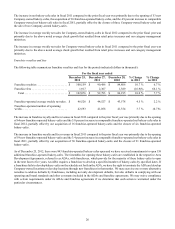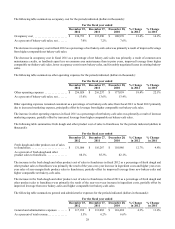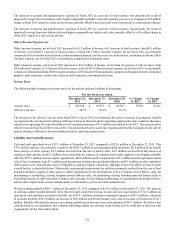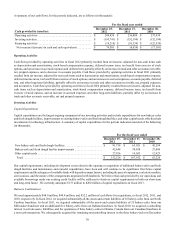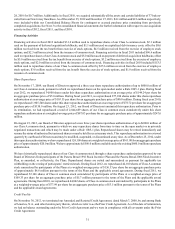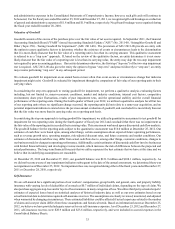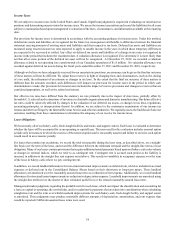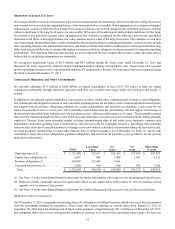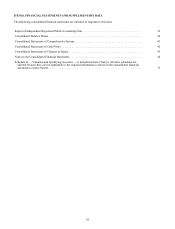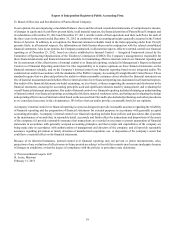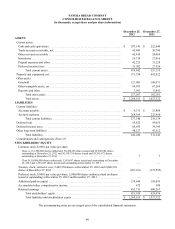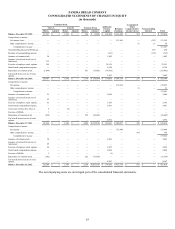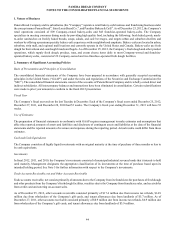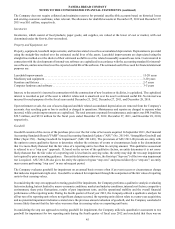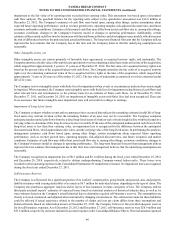Panera Bread 2012 Annual Report Download - page 44
Download and view the complete annual report
Please find page 44 of the 2012 Panera Bread annual report below. You can navigate through the pages in the report by either clicking on the pages listed below, or by using the keyword search tool below to find specific information within the annual report.
36
recorded a liability for certain of these guarantees as they arose prior to the implementation of the accounting requirements for
guarantees and, unless modified, are exempt from its requirements. We have not recorded a liability for those guarantees issued
after the effective date of the accounting requirements because the fair value of each such lease guarantee was determined by us
to be insignificant based on analysis of the facts and circumstances of each such lease and each such franchisee’s or affiliate's
performance, and we did not believe it was probable we would be required to perform under any guarantees at the time the
guarantees were issued. We have not had to make any payments related to any of these guaranteed leases. Applicable franchisees
or affiliates continue to have primary obligation for these operating leases. As of December 25, 2012, future commitments under
these leases were as follows (in thousands):
Total Less than
1 year 1-3
years 3-5
years More than
5 years
Subleases and Lease Guarantees (1) . . . . . . . . . . . . . $ 23,312 3,578 5,933 4,043 9,758
(1) Represents aggregate minimum requirement — see Note 13 to the consolidated financial statements for further information
with respect to our lease guarantees.
Employee Commitments
We have confidential and proprietary information and non-competition agreements, referred to as non-compete agreements, with
certain employees. These non-compete agreements contain a provision whereby employees would be due a certain number of
weeks of their salary if their employment was terminated by us as specified in the non-compete agreement. We have not recorded
a liability for these amounts potentially due to employees. Rather, we will record a liability for these amounts when an amount
becomes due to an employee in accordance with the appropriate authoritative literature. As of December 25, 2012, the total amount
potentially owed employees under these non-compete agreements was $16.7 million.
Impact of Inflation
Our profitability depends in part on our ability to anticipate and react to changes in food, supply, labor, occupancy, and other costs.
In the past, we have been able to recover a significant portion of inflationary costs and commodity price increases, including price
increases in fuel, proteins, dairy, wheat, tuna, and cream cheese among others, through increased menu prices. There have been,
and there may be in the future, delays in implementing such menu price increases, and competitive pressures may limit our ability
to recover such cost increases in their entirety. Historically, the effects of inflation on our consolidated results of operations have
not been materially adverse. However, inherent volatility experienced in certain commodity markets, such as those for wheat, fuel,
and proteins, including chicken and turkey, may have an adverse effect on us in the future. The extent of the impact will depend
on our ability and timing to increase food prices.
A majority of our associates are paid hourly rates regulated by federal and state minimum wage laws. Although we have and will
continue to attempt to pass along any increased labor costs through food price increases, there can be no assurance that all such
increased labor costs can be reflected in our prices or that increased prices will be absorbed by consumers without diminishing to
some degree consumer spending at the bakery-cafes. However, we have not experienced to date a significant reduction in bakery-
cafe profit margins as a result of changes in such laws, and management does not anticipate any related future significant negative
impacts to our results of operations.
ITEM 7A. QUANTITATIVE AND QUALITATIVE DISCLOSURES ABOUT MARKET RISK
Commodity Risk
We manage our commodity risk in several ways. We purchase certain commodities, such as flour, coffee, and proteins, for use in
our business. These commodities are sometimes purchased under agreements of one month to one year time frames usually at a
fixed price. As a result, we are subject to market risk that current market prices may be above or below our contractual price. In
fiscal 2012, 2011, and 2010, we did not utilize derivative instruments in managing commodity risk.
Interest Rate Sensitivity
We are also exposed to market risk primarily from fluctuations in interest rates on our revolving credit facility. Our revolving
credit facility provides for a $250.0 million secured facility under which we may select interest rates equal to (1) LIBOR plus the
Applicable Rate for LIBOR loans (which is an amount ranging from 1.00 percent to 2.00 percent depending on our consolidated
leverage ratio) or (2) the Base Rate (which is defined as the higher of the Bank of America prime rate, the Federal funds rate plus
0.50 percent, or LIBOR plus 1.00 percent) plus the Applicable Rate for Base Rate loans (which is an amount ranging from 0.00
percent to 1.00 percent depending on our consolidated leverage ratio). We did not have an outstanding balance on our credit facility


